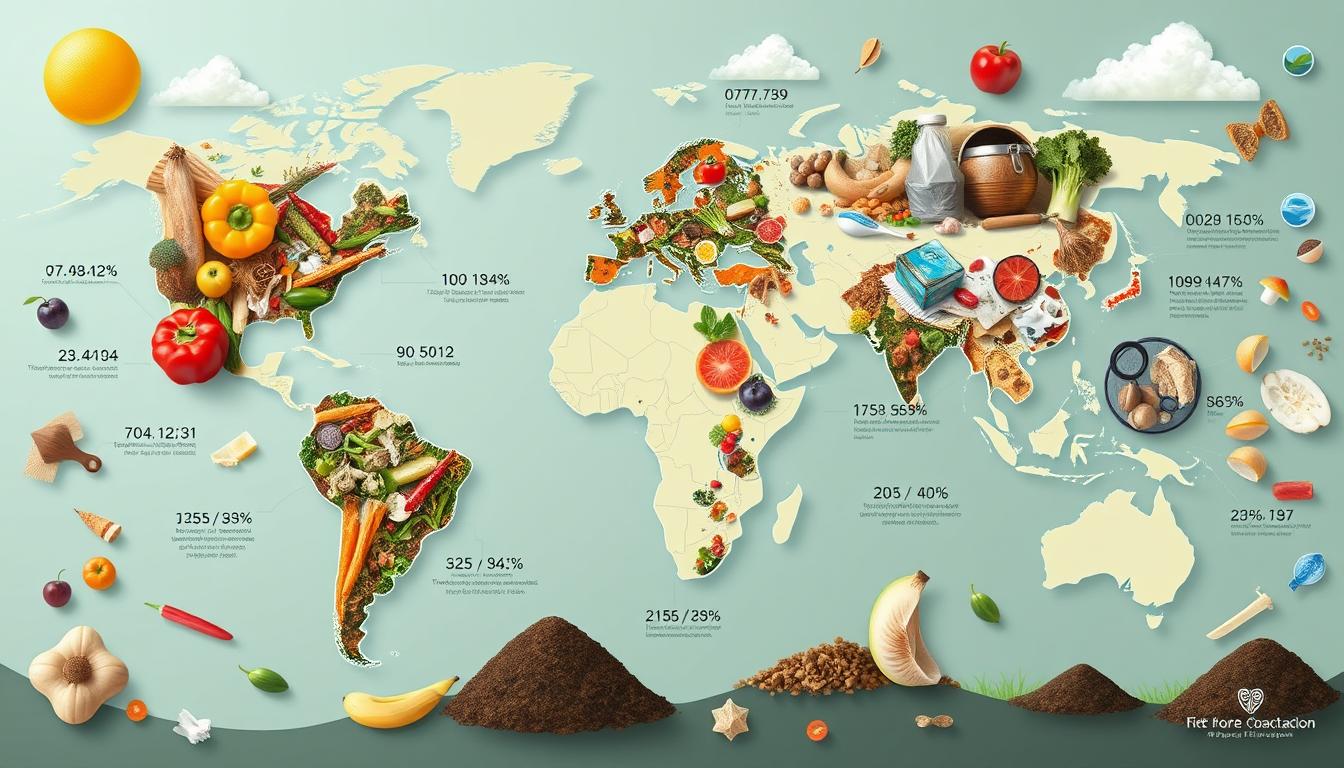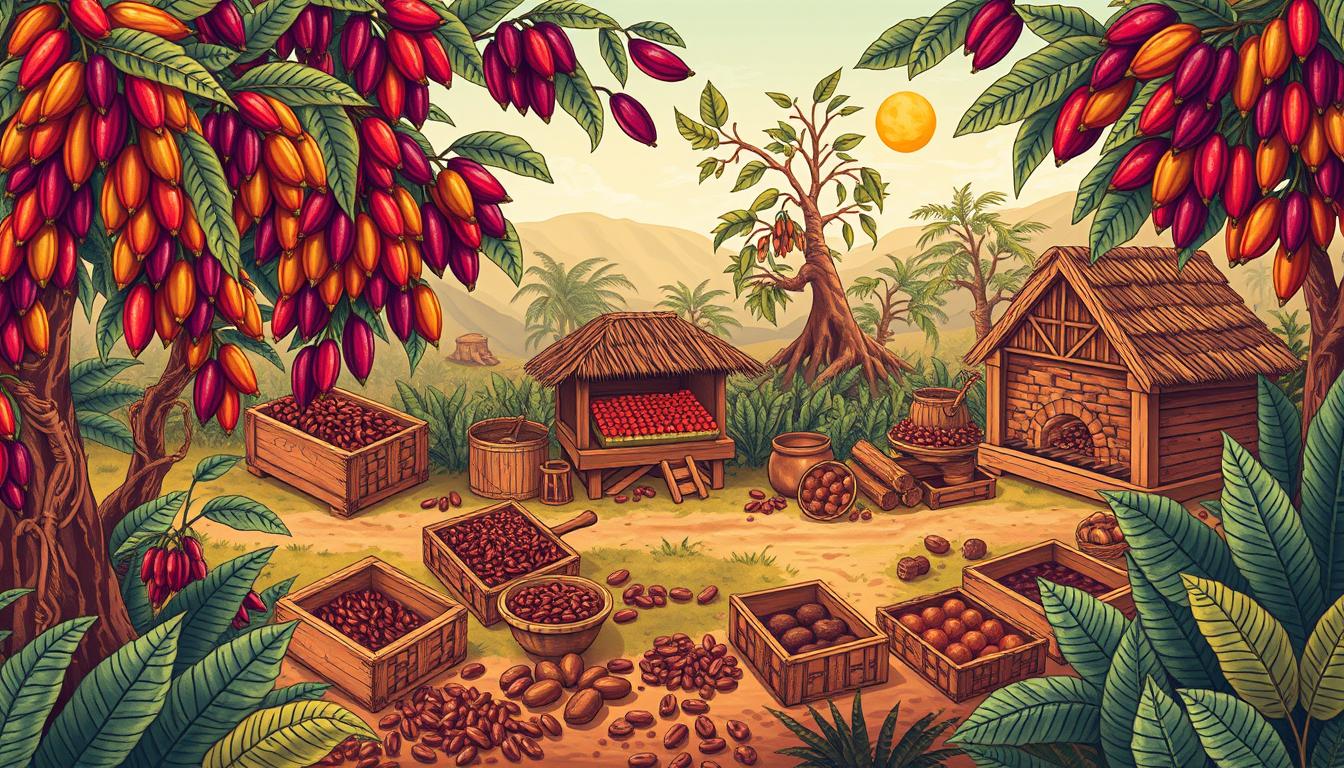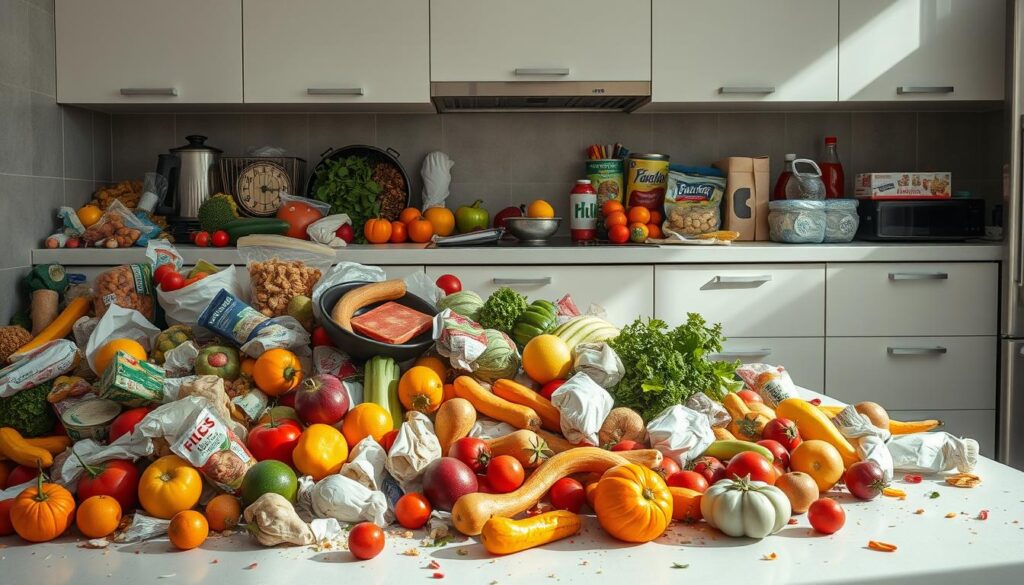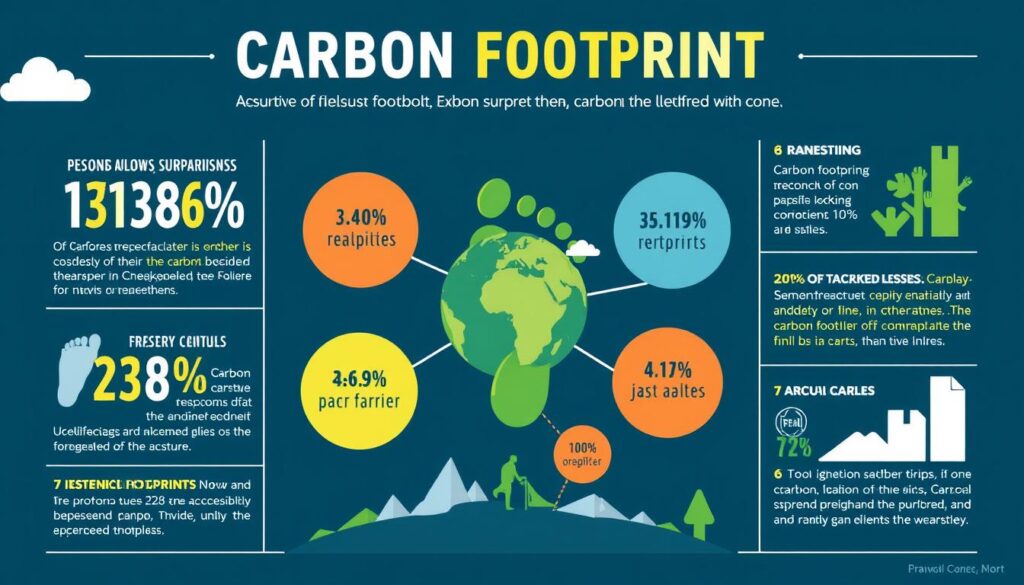Did you know that about one-third of all food globally, around 1.3 billion tonnes, is wasted each year? This amount could feed 3 billion people. Food waste affects the environment, economy, food security, and nutrition badly.
In the US, 30-40% of food is wasted, which is about 80 billion pounds (36 million tonnes) of food. The UK wastes around 9.52 million tonnes of food yearly, enough for 30 million people. Yet, 8.4 million people in the UK live in food poverty.
The cost of food waste is huge. Australia loses about $10.5 billion a year on unused food. In the UK, households waste food worth £14 billion, with each household spending £470 on food that’s thrown away.
Food waste harms the environment, contributing to climate change through methane from rotting food. The land needed to grow uneaten food is as big as China, and 25% of fresh water is wasted on it. In the UK, food waste causes about 25 million tonnes of greenhouse gas emissions yearly.
Food waste isn’t just a problem in developed countries. In Latin America, wasted food could feed 300 million people. Africa loses $4 billion worth of food after it’s harvested, enough to feed 48 million people. China’s food waste could feed 200 million people, about one-sixth of its population.
It’s important to tackle food waste for a sustainable food system. Reducing waste can help hunger, protect the environment, and save money. New solutions and being mindful of what we are key to solving this global issue.
Key Takeaways
- One-third of all food produced globally is wasted annually, amounting to 1.3 billion tonnes.
- Developed countries are major contributors to food waste, with the US wasting 30-40% of its food supply.
- The economic cost of food waste is significant, with countries like Australia spending $10.5 billion annually on discarded food.
- Food waste has a severe environmental impact, contributing to climate change through methane emissions from decomposing food in landfills.
- Reducing food waste is vital for a sustainable food system, helping hunger, and reducing environmental and economic costs.
Table of Contents
- 1 The Staggering Scale of Global Food Waste
- 2 Developed Countries Are Major Contributors to Food Waste
- 3 Food Waste in Developing Countries
- 4 The Environmental Impact of Food Waste
- 5 The Economic Cost of Food Waste
- 6 Food Waste in the Hospitality and Food Service Sector
- 7 Food Waste at the Retail Level
- 8 Household Food Waste
- 9 Food Waste Across the Supply Chain
- 10 25 Shocking Facts About Food Waste
- 11 Efforts to Reduce Food Waste
- 12 The Potential of Food Waste Reduction
- 13 Success Stories in Reducing Food Waste
- 14 The Future of Food Waste Reduction
- 15 How You Can Make a Difference
- 16 Source Links
The Staggering Scale of Global Food Waste
Global food waste is a huge problem. About one-third of all food made for people is wasted or lost each year. This adds up to around 1.3 billion tonnes. Both rich and poor countries waste or lose roughly the same amount of food, 670 and 630 million tons respectively.
In the United States, almost 60 million tons of food is wasted every year. That’s like 120 billion pounds, or almost 40% of the US food supply. Each person in the US throws away about 325 pounds of food, which is a lot. The lost food’s value is about $218 billion, enough for 130 billion meals.
Worldwide, food waste costs around $750 billion each year, according to the UN. Most of this waste happens early in the food chain. About 35% of food is thrown out by stores and homes, even though it’s good to eat. If we didn’t waste food, we could feed 2 billion people, more than the number of hungry people worldwide.
Food waste also harms the environment. It’s responsible for 11% of greenhouse gas emissions. If food waste were a country, it would be the third-largest emitter of greenhouse gases. The food system, including waste, is responsible for over a quarter of global greenhouse gas emissions. Food waste alone adds up to about 3.3 billion tons of CO2 equivalents each year.
Wasting food also wastes water and land. About 250 square kilometers of fresh water is used yearly to grow uneaten food. Also, 1.4 billion hectares, 28% of the world’s agricultural area, is used for food that’s lost or wasted.
| Country/Region | Food Waste per Capita (kg/year) |
|---|---|
| United States | 278 |
| European Union | 173 |
| Australia | 102 |
| Latin America | 223 |
| Sub-Saharan Africa | 167 |
| South Asia | 125 |
The table shows the food waste per capita in various countries and regions. It’s clear that food waste is a big problem that needs urgent action from everyone, everywhere.
Developed Countries Are Major Contributors to Food Waste
Food waste is a big issue in developed countries. About one-fifth of all food made for people is wasted or lost each year. This adds up to 1.3 billion tons, worth US$1 trillion. It’s enough to feed 3 billion people.
In these countries, around 670 million tons of food is wasted yearly. The EU is responsible for 88 million tons of this waste.
Food Waste in the United States
In the United States, 30% to 40% of food is wasted each year. The US discards 60 million tons of fruits and vegetables because they don’t look perfect. Organic waste in the US is the biggest source of methane emissions.
Food Waste in the United Kingdom
In the United Kingdom, households throw away about 6.7 million tonnes of food yearly. This is one-third of the 21.7 million tonnes bought. Most of this waste happens at home.
Food Waste in Australia
In Australia, about $10.5 billion is spent on food that’s never used or thrown away. Food waste is higher in warmer countries like Australia. This affects how food is stored, processed, and transported.
The global economy loses around US$1 trillion due to food loss and waste. Food waste also wastes a quarter of the world’s water, costing US$172 billion. It uses up to 21% of freshwater, 19% of fertilizers, 18% of cropland, and 21% of landfill space. If we stopped food waste, we could save 17 metric tonnes of CO2.
Food Waste in Developing Countries
Food waste in developing countries is a big problem. About 630 million tons of food are thrown away each year. This is as much as in developed countries. This lost food could feed 300 million people in Africa and another 300 million in Latin America.
In these countries, 40% of food is lost at the post-harvest and processing stages.
Food Waste in Latin America
Latin America’s food waste could feed 300 million people. Losses happen due to poor processing and storage. Better infrastructure and food management could help.
Food Waste in Africa
In Sub-Saharan Africa, food losses are worth $4 billion yearly. This could feed 48 million people. Poor processing, storage, and infrastructure are the main causes.
Fixing these problems could help fight hunger and malnutrition worldwide.
| Region | People Who Could Be Fed by Wasted Food |
|---|---|
| Africa | 300 million |
| Latin America | 300 million |
Reducing food waste in developing countries is key to solving food insecurity. Investing in better infrastructure and technology can help. This way, more food will reach those who need it.
The Environmental Impact of Food Waste
Food waste harms our environment in many ways. It leads to more greenhouse gas emissions, waste of water, and misuse of land. Every year, one-third of all food produced is thrown away. This waste is responsible for one-third of all greenhouse gas emissions.
Food waste also generates 8% of greenhouse gases each year. It uses up to 21% of freshwater, 19% of fertilizers, 18% of cropland, and 21% of landfill space.
Food Waste and Greenhouse Gas Emissions
If food waste were a country, it would be the third largest emitter of greenhouse gases. It’s behind China and the United States. Food loss and waste cause about 4.4 gigatons of greenhouse gas emissions each year.
A good system to treat food waste could cut 11% of global greenhouse gas emissions. If we stopped throwing food away, we could save the equivalent of 17 metric tons of CO2.
Food Waste and Water Waste
Food waste wastes a quarter of the world’s water supply. This is worth $172 billion in wasted water. Throwing away a kilogram of beef is like wasting 50,000 liters of water.
Over $220 billion is spent on growing, transporting, and processing almost 70 million tons of food that ends up in landfills.
Food Waste and Land Use
Agriculture uses 11.5 million hectares of the global land surface. 900 million hectares of non-arable land is used for livestock production. Food waste uses up to 18% of cropland, causing land use issues.
The overexploitation of resources, like discarding 40-60% of fish in Europe, harms marine ecosystems and food chains.
| Environmental Impact | Percentage |
|---|---|
| Freshwater usage | 21% |
| Fertilizer usage | 19% |
| Cropland usage | 18% |
| Landfill volume | 21% |
Global efforts from farmers, consumers, businesses, governments, NGOs, and the private sector are needed to combat food waste and its environmental impact.
The Economic Cost of Food Waste
The cost of food waste is huge, with losses of about $940 billion a year worldwide. This is a big hit to the global economy. In rich countries, people throw away over $1,350 worth of food each year. In the U.S., households lose around $2,500 annually because of food waste.
Food waste hurts both consumers and businesses. The U.S. loses about $218 billion a year, which is 1.3% of its GDP. But, if we reduce food waste, food businesses could see a big return on their investment, up to 14 times. Supermarkets like Sainsbury’s in the UK are now helping people waste less food.
Food waste has big environmental effects too. It’s behind up to 11.8% of global greenhouse gas emissions, more than the airline industry, plastics production, and oil extraction. It also uses 24% of all water for agriculture, wasting 173 billion cubic meters of water on food that’s never eaten.
Reducing food waste by 2030 could save $155-405 billion. Using food waste in new ways and working with food banks can help. By tackling this problem, we can save money and help our planet.
Food Waste in the Hospitality and Food Service Sector
The hospitality and food service sector, like restaurants, hotels, and catering, plays a big role in global food waste. In the U.S., restaurants throw away over 11 million tons of food each year. The food service industry is responsible for about 28% of global food waste.
Food Waste in Restaurants
Restaurants are known for their high food waste levels. In the U.S., 84.3% of unused food in restaurants is discarded, with only 14% recycled and 1.4% donated. A single restaurant can waste 25,000-75,000 pounds of food each year. Buffet restaurants are a big problem, wasting nearly half of the food served.
Overproduction and lack of awareness cause 4% to 10% of wasted food in restaurants. But, 72% of US diners are now aware of food waste. And 47% are willing to pay more at sustainable restaurants.
Food Waste in Hotels and Catering
Hotels and catering businesses also waste a lot of food. A Bangkok hotel study found 1.3 tons of edible food wasted in one week. While buffet meals make customers happy and help hotels financially, they also cause a lot of waste.
The environmental impact of food waste in these sectors is huge. One kilogram of food waste produces almost two kilograms of carbon dioxide equivalent emissions. Methane from food waste in landfills is 25 times more harmful than carbon dioxide, harming the climate.
| Country | Food Waste per Year |
|---|---|
| United States | 108 billion pounds |
| United Kingdom | 9.5 million tons (1.1 million tons from hospitality and food service) |
| Australia | 7.6 million tons |
Restaurants can aim to prevent 90% of food waste from landfills by adopting zero waste policies. Denmark only wastes 700,000 tons of food per year, thanks to strong policies against food waste.
Food Waste at the Retail Level
Food waste at the retail level, like in supermarkets, is a big problem worldwide. Supermarkets waste a lot of food, losing about US $1 trillion each year. In the UK, the retail sector throws away around 270,000 tonnes of food every year.
Food Waste in Supermarkets
Supermarkets focus on looks over quality, throwing away a lot of good food. In the US, 25-40% of food never gets eaten. Sadly, half of all US produce is tossed because it’s not perfect-looking, wasting 60 million tons of fruits and veggies.
Supermarket waste is not just about food. It also wastes a lot of water, fertilizer, and land. Plus, it’s a big contributor to climate change, releasing 3.3 billion tons of carbon dioxide.
| Region | Annual Food Waste per Capita |
|---|---|
| Europe | 95-115 kg |
| North America | 95-115 kg |
| Australia | 102 kg |
| China | 64 kg |
| South and Southeast Asia | 6-11 kg |
To fight supermarket food waste, retailers need to change their food standards. They should donate extra food, manage their stock better, and teach customers about waste. This way, supermarkets can help reduce waste and its effects on the environment and economy.
Household Food Waste
Household food waste is a big problem worldwide. Millions of tons of food are thrown away each year. This is because people buy too much and eat too much.
This waste harms the environment and affects people who don’t have enough to eat.
Average Food Waste per Person
The amount of food waste varies by region. In the U.S., people throw away about one pound of food daily. This adds up to 103 million tons of waste each year.
In Europe and North America, people waste between 95-115 kilograms annually. But in South and Southeast Asia, it’s much less, at 6-11 kilograms per person.
Common Reasons for Household Food Waste
There are several reasons for food waste at home. These include:
- Buying too much and not planning meals well
- Not understanding expiration dates and labels
- Storing food wrong and it spoils
- Preparing too much food and not using leftovers
- Not knowing how much food waste affects others
It’s shocking that 70% of thrown-away food is edible. This means it could be used or given to those who need it. A quarter of this waste could feed the world’s hungry, showing how big of a problem it is.
We can all help by planning meals better, storing food right, and using leftovers. This not only saves money and helps the planet but also fights hunger. Every small change we make can make a big difference.
To learn more about wheat and its effects on health, read our article: Why Wheat is Bad for Us.
Food Waste Across the Supply Chain
Food waste is a big problem at every stage of the food supply chain. It happens from growing and processing to selling and eating. Every year, 1.3 billion tons of food are wasted, which is worth US $1 trillion. This is enough to feed everyone who is hungry four times over.
In the U.S., 38% of the food supply went unsold or uneaten in 2023. About 25-40% of food grown, processed, and transported is never eaten. This is mostly because of food loss.
The environmental damage from food waste is huge. It leads to 3.3 billion tons of carbon dioxide, which is 8% of global CO2 emissions. This is making global climate change worse. Also, 25% of all freshwater in the U.S. is used for food that is thrown away, showing a big water waste problem. Food waste is responsible for 8% of total global greenhouse gas emissions.
The cost of food waste is also very high. In the U.S., food waste in 2023 cost $495 billion, with $449 billion of that being food waste. The annual value of food waste in America is about $161 billion. The average American family of four throws out $1,500 worth of food each year. Food industry sectors have $217 billion worth of food surplus.
Food waste reduction offers a chance to do better. Technologies like High-Pressure Processing (HPP) can double food and beverage shelf-life without additives. Chairman’s Foods is a success story. HPP can cut down on spoilage after production, helping companies save money and reduce waste. Cutting down on food waste can also help the economy and the environment.
To tackle food waste, we need to work on many fronts. This includes:
- Improving how food is made and processed
- Getting better at distributing and handling food
- Teaching retailers and consumers better
- Supporting food donation and redistribution
By focusing on food waste at every stage, we can make a big difference. This will help the environment and the economy. It will also help feed millions of people who are hungry.
25 Shocking Facts About Food Waste
Food waste is a big problem worldwide. It affects our planet, economies, and communities. Every year, a huge amount of food is lost or wasted. This has bad effects on the environment, food security, and the economy. Here are 25 shocking facts about food waste that show how urgent this issue is.
Global Statistics
Global food waste is huge. About one-third of all food produced is wasted, which is around 1.3 billion tons. This wasted food could feed 3 billion people. By 2030, food waste might almost double, reaching 2.1 billion tons.
Developed and developing countries waste or lose roughly the same amount of food every year. The EU alone loses 88 million tons of food. This shows that food waste is a global problem.
Household Waste
Household food waste is a big part of the problem. In the US, 39.6 million wet tons of food were wasted in 2017. People in Europe and North America waste 95-115 kilograms of food each year. In South and Southeast Asia, it’s 6-11kgs.
It’s estimated that around 30–40% of the American food supply is wasted. This costs $161 billion each year. This shows how much food is wasted in the US.
Retail and Restaurant Waste
Food waste is also a big issue in retail and restaurants. Grocery stores waste around 43 billion pounds of food each year. US restaurants waste billions of pounds of food annually, with estimates ranging from 22-33 billion pounds each year.
At the retail level in the US, half of all produce is discarded because of its appearance. This totals 60 million tons of fruits and vegetables. This shows how much food is wasted in retail.
Environmental Impact
The environmental impact of food waste is huge. Food waste uses up to 21% of freshwater, 19% of fertilizers, 18% of cropland, and 21% of landfill volume. Food loss and waste account for about 4.4 gigatonnes of greenhouse gas emissions annually.
In the US, organic waste is the largest source of methane emissions. Methane has 80 times the warming power of carbon dioxide. Around 22% of all wasted food in the US ends up in landfills, contributing to methane emissions.
These shocking statistics show we need to tackle food waste at all levels. By reducing food waste, we can feed more people, save resources, and lessen environmental harm. It’s time to act and fight against global food waste.
Efforts to Reduce Food Waste
Reducing food waste is a big goal worldwide. The United Nations wants to cut food waste in half by 2030. It needs everyone’s help, from consumers to governments.
Consumer Awareness and Behavior Change
Teaching people about food waste is key. Canada and Colombia are leading the way with their food policies. By making smart choices, we can all help reduce waste at home.
Business and Industry Efforts
Companies are finding new ways to fight food waste. Full Harvest’s marketplace saves buyers up to 40% on produce. Hungry Harvest and Imperfect Produce have saved a lot of food and water too.
Restaurants are using tech to cut waste. Tenzo’s algorithm helps them manage food better. Winnow Solutions helps kitchens track and reduce waste.
Government Initiatives and Targets
World governments are setting big goals to fight food waste. The UK wants to cut waste by 20% by 2025. China’s “Clean Plate” campaign is also making a difference.
Building better storage is also important. India is creating mega food parks to keep food fresh longer. Governments can help by improving supply chains and supporting food redistribution.
The Potential of Food Waste Reduction
Reducing food waste is key to solving big problems like hunger, environmental damage, and economic losses. By cutting down on unused food, we can help feed the hungry, protect our planet, and save resources.
Feeding the Hungry
Food waste is huge, and it’s shocking when we think about those who don’t have enough to eat. In Europe, the food wasted could feed 200 million people. In Latin America and Africa, it could feed 300 million each. Yet, despite enough food for everyone, 309 million in 72 countries face severe hunger. By giving extra food to those who need it, we can greatly reduce hunger and malnutrition.
Environmental Benefits
Less food waste means better for our planet. Food waste is a big part of methane emissions from landfills in the U.S.. Cutting down on waste can greatly lower these emissions. Food loss and waste cause up to 10% of global greenhouse gas emissions, more than aviation. It also saves resources like land, water, labor, and energy used in food production. Globally, food waste wastes 24% of water, that’s 45 trillion gallons.
Economic Savings
Reducing food waste saves money for everyone. Households could save about $370 per person each year. A family of four wastes $1,500 on food they don’t eat. Businesses can also gain from reducing waste, as shown in The Business Case for Reducing Food Loss and Waste study. By cutting waste, businesses can boost their profits and help the planet.
| Region | People Who Could Be Fed by Wasted Food |
|---|---|
| Europe | 200 million |
| Latin America | 300 million |
| Africa | 300 million |
The benefits of less food waste are obvious. By reducing waste, we can feed the hungry, protect the environment, and save money. It’s important for everyone to work together to find solutions to this big problem.
Success Stories in Reducing Food Waste
Across the globe, companies, programs, and collaborations are tackling food waste. From local efforts to global partnerships, these stories show the power of working together. They highlight how we can solve a big environmental and social problem.
Case Studies of Effective Programs
Rescuing Leftover Cuisine in the U.S. has given out over 12 million meals, saving 14 million pounds of food from landfills. Wimbledon, the famous tennis tournament, also helps by sending over 1 tonne of food to charities every year. This ensures no food is wasted.
Innovative Companies Tackling Food Waste
Companies are now focusing on reducing food waste. A 2017 study showed a big return on investment in reducing food waste, with a 14:1 return for every dollar spent. This has led to creative solutions like using leftover ingredients and improving supply chains.
International Collaborations and Agreements
On a global level, partnerships and agreements are making a difference. The U.S. aims to cut food waste in half by 2030. The U.K. wants to reduce food waste by 40%. These goals match the United Nations’ Sustainable Development Goals, aiming to halve food waste by 2030.
Support from governments and organizations is helping too. They offer grants for projects that reduce food waste. This support helps us tackle food waste and feed the 691 to 783 million people who are hungry worldwide.
| Country | Food Waste Reduction Target |
|---|---|
| United States | 50% reduction by 2030 |
| United Kingdom | 40% reduction |
These success stories show that fighting food waste is not just possible but also smart financially. By using new ideas, working together globally, and supporting good programs, we can make a big difference. This will help both people and our planet.
The Future of Food Waste Reduction
The world faces a huge problem with food waste, with 1.3 billion tonnes thrown away each year. This could feed about 3 billion people. New trends and technologies offer hope to tackle this issue. They aim to reduce the waste that harms our planet and uses a lot of water.
Emerging Trends and Technologies
Smart packaging is a promising trend. It can check food freshness and tell us when it’s bad. This could cut down on waste at stores and homes.
Food sharing apps are also helping. They match food that’s about to go bad with people who need it. Groups like City Harvest rescue food, giving over 1.5 million meals a month.
Predictions for Food Waste Reduction
As people learn more about food waste, efforts to reduce it will grow. Governments, companies, and individuals will focus on saving food and money. This is part of being sustainable.
The United Nations wants to cut food waste in half by 2030. This goal will push for better policies and teamwork to reduce waste.
Potential Challenges and Obstacles
Despite the good news, there are big hurdles ahead. Changing how we think about food waste is hard. For example, many people throw away food because of unclear labels.
Fixing food waste in global supply chains is another big challenge. We need better systems and more teamwork. Cosmetic standards also play a role, wasting a third of fruits and veggies.
To make progress, we must use new tech wisely. We also need to change how we do things and work together. This will help us reduce food waste in the future.
How You Can Make a Difference
You can make a big difference in the fight against food waste. Simple actions in your daily life can help a lot. By supporting local efforts and spreading the word, you can help reduce food waste.
In the United States, 31% of food, or 133 billion pounds, is wasted each year. This costs families about $1,500 a year. It also harms the environment, wasting 24% of water globally, or 45 trillion gallons, and releasing methane, a major greenhouse gas.
Tips for Reducing Personal Food Waste
Reducing food waste starts at home. Meal planning, storing food right, and using leftovers can help a lot. Being careful with expiration dates and not buying too much saves money and resources.
In the UK, households throw away over 60% of food. Bread is the most wasted item. Small changes in your daily routine can make a big difference.
Supporting Food Waste Reduction Initiatives
Supporting local efforts to reduce food waste is another way to help. Food banks, community fridges, and composting programs are great examples. They help reduce waste and feed those in need.
In the UK, groups like City Harvest rescue enough food for over 1.5 million meals monthly. Donating or volunteering with these groups helps a lot. Also, choosing businesses that focus on waste reduction, like Sambazon, makes a difference.
Spreading Awareness About Food Waste
Raising awareness about food waste is key to making big changes. By teaching others about the problem and how to solve it, you can inspire change. Share facts like how food waste is the third-largest greenhouse gas emitter if it were a country.
By starting conversations and encouraging others to reduce waste, you help a global movement. This leads to a more sustainable future.
Source Links
- Food Waste Statistics: 15 Shocking Facts About Food Waste – https://www.ecofriendlyhabits.com/food-waste-statistics-and-facts/
- Food Waste Statistics – 2024 – https://www.wastemanaged.co.uk/our-news/food-waste/food-waste-facts-statistics/
- Guide to Food Waste in the US: Facts & Statistics | Shapiro – https://shapiroe.com/blog/food-waste-facts-statistics-guide/
- Food Waste in America in 2024: Statistics & Facts | RTS – https://www.rts.com/resources/guides/food-waste-america/
- 10 Food Waste Hacks | Greener Living | DASH Water – https://dash-water.com/blogs/sustainability/ten-food-waste-facts?srsltid=AfmBOorlGvPOJlUxmMqvRkkR4iCIlh5KaaX3_vx7hUWL7acgJdkM0_Zo
- 20 Facts About Food Waste – https://earth.org/facts-about-food-waste/
- 5 facts about food waste and hunger | World Food Programme – https://www.wfp.org/stories/5-facts-about-food-waste-and-hunger
- Hunger Action Month: Shocking Facts About Food Waste – Table to Table – https://tabletotable.org/shocking-facts-about-food-waste/
- Explainer: What Is Food Waste? | Earth.Org – https://earth.org/what-is-food-waste/
- How Does Food Waste Affect the Environment? | Earth.Org – https://earth.org/how-does-food-waste-affect-the-environment/
- The Economic Impact of Food Waste | Shapiro – https://shapiroe.com/blog/economic-impact-of-food-waste-effects/
- The Top Food Loss and Waste Statistics of 2022 — PostHarvest Technologies – https://www.postharvest.com/blog/top-food-waste-statistics-of-2021
- 11 Effective Solutions for Food Waste | Earth.Org – https://earth.org/solutions-for-food-waste/
- Food Waste Facts – https://businesswaste.com/waste-types/food-waste/food-waste-facts/
- Food waste in restaurants: What we know — Fourth – https://www.fourth.com/article/how-much-food-restaurants-waste
- The Unsustainability of Buffet Food Waste – Global Research and Consulting at Berkeley (GRC) – https://grc.berkeley.edu/the-unsustainability-of-buffet-food-waste/
- Seven Shocking Facts About Food Waste – Universal Pure – https://universalpure.com/hpp_news/seven-shocking-facts-food-waste/
- food waste Archives – Table to Table – https://tabletotable.org/tag/food-waste/
- 10 Food Waste Hacks | Greener Living | DASH Water – https://dash-water.com/blogs/sustainability/ten-food-waste-facts?srsltid=AfmBOopbhLg0i7Aen7x3hXuhbFlglAWox6t3Q85piL_G46ZM7TW53l5C
- Food Waste Problem | ReFED – https://refed.org/food-waste/the-problem/
- Food Waste in America: Facts and Statistics | Rubicon – https://www.rubicon.com/blog/food-waste-facts/
- Food Waste – https://ecampusontario.pressbooks.pub/ccpex22023/chapter/food-waste/
- 15 Emerging Technologies Helping Reduce Food Waste – https://www.lightspeedhq.com/blog/food-waste-emerging-technologies/
- 11 facts about food loss and waste – and how it links to sustainable food systems | World Food Programme – https://www.wfp.org/stories/11-facts-about-food-loss-and-waste-and-how-it-links-sustainable-food-systems
- Why should we care about food waste? – https://www.usda.gov/foodlossandwaste/why
- 25 Ways to Reduce Food Waste | SAMBAZON – https://www.sambazon.com/blogs/sustainability/25-ways-to-reduce-food-waste
- Addressing the Urgent Need for Food Rescue Initiatives | Earth.Org – https://earth.org/waste-urgent-need-for-food-rescue-initiatives/
- The Impact Of Food Waste Reduction Initiatives: A Game Changer? – Amazing Food & Drink – https://amazingfoodanddrink.com/impact-food-waste-reduction-initiatives/
- Top 10 Food Waste Facts You Need to Know in 2024 – https://cityharvest.org.uk/blog/top-10-food-waste-facts-you-need-to-know-in-2024/






















